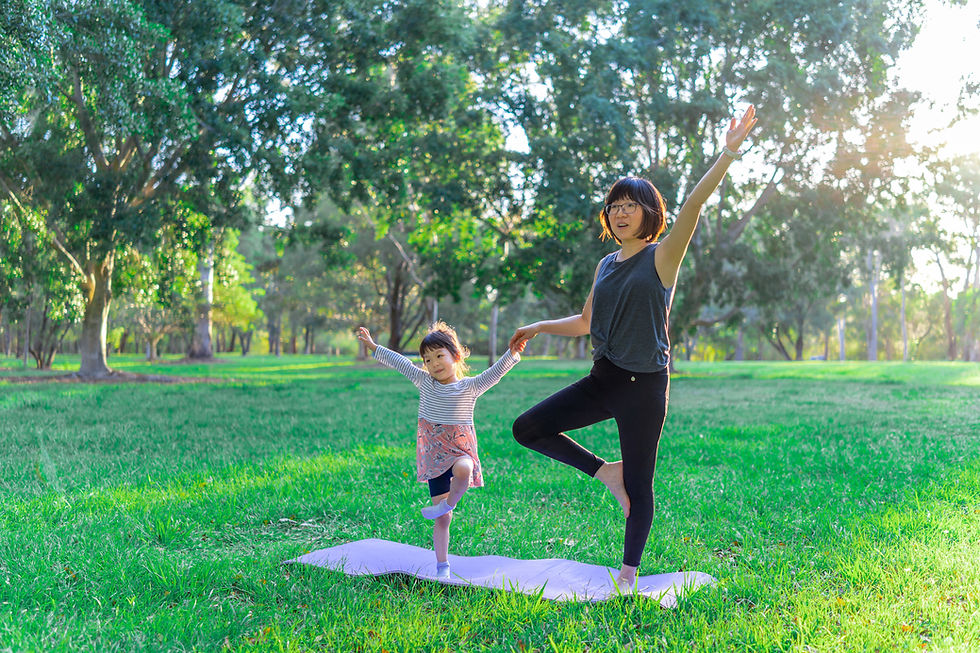How to improve your balance?
- Rafael Claveau

- Feb 20
- 3 min read

Introduction:
When we were young, we worked hard to improve our balance and propel ourselves forward efficiently. We further improved our balance when we were children, through rope skipping, tree climbing, somersaults and simply physical activity.
But as adults, most of us have stopped making these spontaneous movements.Instead, we spend a lot of time sitting, during our trips, at our desks, on the couch. Result: our legs, lower back and buttocks weaken and our balance suffers.
A more sedentary lifestyle is not the only thing to blame. The parts of the inner ear and brain that control balance - what's called the vestibular system and vision decline as we age, which has a significant impact on our balance. This is a gradual slowing that can take years, even decades, to notice. It may have become a bit more difficult to make lateral movements on the tennis court, or you feel less stable when you go down the stairs. Or maybe you feel too precarious in high heels these days. Feeling more confident about these everyday movements and others, such as getting in and out of the car or watering the garden, this is exactly why balance training is so important!

What is Balance training?
Balance training is a form of exercise that focuses on improving body control, stability, and coordination. It typically involves exercises that challenge the body to hold a position or move on an unstable surface. These exercises can challenge the body in various ways, such as by engaging core muscles, improving proprioception, and increasing muscular strength and endurance. Balance training can be used to improve balance and coordination in athletes, reduce the risk of falls in older adults, and provide rehabilitation after an injury.

Improving you balance typically involves exercises that challenge the body's ability to remain balanced, either statically (without movement) or dynamically (with movement). Exercises can involve standing on one foot, agility drills, and balance boards, as well as exercises that require the use of bodyweight and resistance bands. Balance training is beneficial for athletes, as well as people looking to improve their everyday balance and coordination.

How does balance work?
Body Balance is the ability to control and coordinate your body’s movements. It is a complex process that relies on input from your eyes, inner ears, muscles, and joints. Your brain then processes and interprets this information to help you maintain your balance.
Who needs to train their balance?
Simple answer :) Anyone who wants to improve their overall fitness and coordination can benefit from balance training. This includes people of all ages and athletic abilities.

How can you train and improve your balance?
Here are a few ways and examples of how you can improve your balance
1. Single-Leg Balance Exercises: Standing on one leg, with eyes open and then closed, can help to improve your balance. Try standing on one leg with your arms straight out or arms crossed over the chest.
2. Heel-Toe Walking: Walking on your heel and toes (or just your toes) can help to strengthen your ankles and improve balance.
3. Balance Board: Standing on a balance board, or even a pillow, can help to improve balance by making you focus on your center of gravity.
4. Tai Chi: Tai chi is a Chinese martial art that involves slow, graceful movements and focuses on balance and relaxation.
5. Yoga: Many yoga poses require balance, helping to improve your overall balance.
6. Pilates: Pilates focuses on strengthening the core muscles in the body, which can help improve balance.
7. Strength Training: Strengthening the muscles in your legs and core can help to improve your overall balance.
8. Agility Training: Working on agility drills and ladder drills can help to improve balance and coordination.

Train your balance anytime, anywhere!
I would suggest to train your balance as often as possible, at least 2-3 times a week for about 5 minutes each time, it doesn't need to take long and you can do it wherever it's safe and convenient for you.
It can be before a training session as a warm up or in between exercises, in between phone calls at the office, while waiting for a public transport, while taking the elevator, just kidding, I would definitely suggest avoiding the elevator, let's take the stairs ;)
You can use a chair or stay close to a countertop or a table as the beginning to hold onto it till you get more comfortable and confident.
You can find some body-weight exercise on this website in the balance library, I hope this could help. Feel free to reach out to me if you have any questions :)

Thank you,
Rafael















